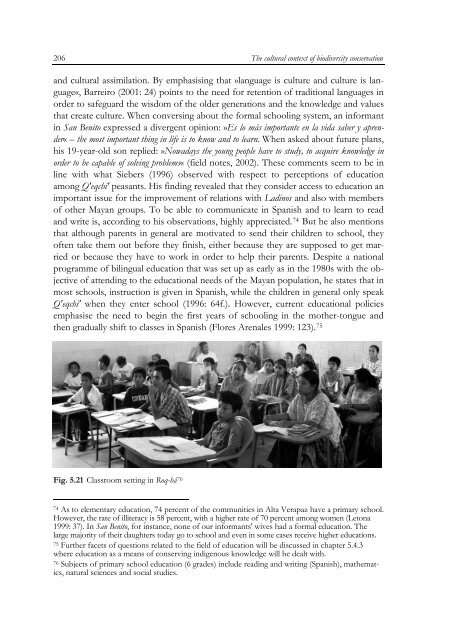The cultural context of biodiversity conservation - Oapen
The cultural context of biodiversity conservation - Oapen
The cultural context of biodiversity conservation - Oapen
Create successful ePaper yourself
Turn your PDF publications into a flip-book with our unique Google optimized e-Paper software.
206<br />
<strong>The</strong> <strong>cultural</strong> <strong>context</strong> <strong>of</strong> <strong>biodiversity</strong> <strong>conservation</strong><br />
and <strong>cultural</strong> assimilation. By emphasising that »language is culture and culture is language«,<br />
Barreiro (2001: 24) points to the need for retention <strong>of</strong> traditional languages in<br />
order to safeguard the wisdom <strong>of</strong> the older generations and the knowledge and values<br />
that create culture. When conversing about the formal schooling system, an informant<br />
in San Benito expressed a divergent opinion: »Es lo más importante en la vida saber y aprender«<br />
– the most important thing in life is to know and to learn. When asked about future plans,<br />
his 19-year-old son replied: »Nowadays the young people have to study, to acquire knowledge in<br />
order to be capable <strong>of</strong> solving problems« (field notes, 2002). <strong>The</strong>se comments seem to be in<br />
line with what Siebers (1996) observed with respect to perceptions <strong>of</strong> education<br />
among Q'eqchi' peasants. His finding revealed that they consider access to education an<br />
important issue for the improvement <strong>of</strong> relations with Ladinos and also with members<br />
<strong>of</strong> other Mayan groups. To be able to communicate in Spanish and to learn to read<br />
and write is, according to his observations, highly appreciated. 74 But he also mentions<br />
that although parents in general are motivated to send their children to school, they<br />
<strong>of</strong>ten take them out before they finish, either because they are supposed to get married<br />
or because they have to work in order to help their parents. Despite a national<br />
programme <strong>of</strong> bilingual education that was set up as early as in the 1980s with the objective<br />
<strong>of</strong> attending to the educational needs <strong>of</strong> the Mayan population, he states that in<br />
most schools, instruction is given in Spanish, while the children in general only speak<br />
Q'eqchi' when they enter school (1996: 64f.). However, current educational policies<br />
emphasise the need to begin the first years <strong>of</strong> schooling in the mother-tongue and<br />
then gradually shift to classes in Spanish (Flores Arenales 1999: 123). 75<br />
Fig. 5.21 Classroom setting in Roq-há 76<br />
74 As to elementary education, 74 percent <strong>of</strong> the communities in Alta Verapaz have a primary school.<br />
However, the rate <strong>of</strong> illiteracy is 58 percent, with a higher rate <strong>of</strong> 70 percent among women (Letona<br />
1999: 37). In San Benito, for instance, none <strong>of</strong> our informants' wives had a formal education. <strong>The</strong><br />
large majority <strong>of</strong> their daughters today go to school and even in some cases receive higher educations.<br />
75 Further facets <strong>of</strong> questions related to the field <strong>of</strong> education will be discussed in chapter 5.4.3<br />
where education as a means <strong>of</strong> conserving indigenous knowledge will be dealt with.<br />
76 Subjects <strong>of</strong> primary school education (6 grades) include reading and writing (Spanish), mathematics,<br />
natural sciences and social studies.

















